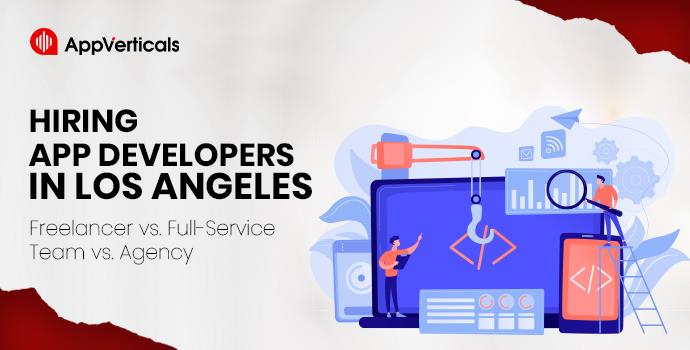In 2025, building scalable and cost-efficient mobile apps is more competitive than ever. With users spending an average of 4.8 hours daily on apps, businesses can’t afford to rely on weak foundations. That’s why choosing the right mobile app framework is critical—it determines speed, cost, performance, and scalability.
In this guide, we’ll break down the best mobile app frameworks of 2025 for cross-platform development, highlight their strengths, and show how they help startups and enterprises—especially in tech-driven hubs like Los Angeles—launch apps that stand out and scale fast.
Why Mobile App Framework Choice Matters for Businesses and Startups
Choosing the right framework isn’t only a developer’s decision, it’s a critical part of your business strategy. The framework you pick will determine the scalability, time-to-market and long-term ROI of your app. In 2025, the competition is tightening every day and each of the following factors have high stakes if you want to launch a successful startup in Los Angeles.
Time-to-Market Pressure
Startups often require launching quickly in order to capture the adequate market share. A strategically picked cross-platform mobile app framework can help you launch simultaneously for both IOS and Android, cutting-down the development cycles by 30-40% in comparison to the native-only builds.
Cost Efficiency
Building individual apps for each platform can double the cost of mobile app development. Leveraging frameworks as of React Native and Flutter, companies can save up to 40% on development costs while maintaining a native-like user experience.
User Expectations
The users of today expect engaging yet seamless experiences. Statista suggests that an average of 25% apps are abandoned by the users after one-tie use – most likely because of the technical glitches and poor UX. Choosing the wrong foundation can increase your risk of losing user retention.
Scalability for Growth
Startups that have the potential to scale quickly often outgrow poorly chosen tech stacks. Frameworks that come along with strong community support, frequent updates and third-party integrations can help ensure the app remains future-ready.
If you’re a business leader or a founder, the question isn’t ‘what can my developers use?’ but ‘what framework ensures my product meets business goals, scales effectively and reduces costs?’ If the framework you choose meets all these criteria, you’re good to go.
Find the Right Framework for Your App
Choosing the wrong foundation can cost time and money. Our experts help you pick the framework that fits your goals, budget, and growth plans.
What Makes a Framework Best In 2025?
Not all mobile app frameworks are created equal. With so many options available, businesses certainly require proper benchmarking to determine which of the options align with their goals. In 2025, the best mobile app development framework isn’t just about popularity but it’s more about balancing cost, scalability and performance.
Here’s a breakdown of some critical factors that can help you choose the right cross-platform development tools or frameworks:
Performance and Speed
it is important to ensure that the apps run seamlessly across both ios and android without any lags. Frameworks like Flutter Skia that have near-native rendering engines can deliver 60-120 FPS, guaranteeing faster load times and seamless animations.
Cross-Platform Efficiency
The core benefit of adapting cross-platform frameworks is that they offer single codebase deployment. The best tools you’ll find in 2025 have the ability to cut-down code rewrites and reduce development cycles by almost 40% while ensuring the outcome remains consistent across varying devices.
UI/UX Flexibility
A seamless user experience is directly tied to retention. Almost 90% of users stop using an app due to poor performance or design, reports Forbes, 2024. The best frameworks for mobile app development in 2025 offer robust UI libraries, adaptive design systems, and responsive components that allow businesses to create visually rich, user-friendly interfaces. This flexibility helps startups deliver apps that feel “native,” even when built cross-platform.
Scalability and Integration
Modern businesses cannot ignore scalability. A strong framework should support future integrations with AI, IoT, AR/VR, and cloud-native services. For example, Flutter and React Native already provide API compatibility and plugin ecosystems that simplify scaling. This ensures your app grows with your business, whether you’re expanding user capacity, adding new features, or entering new markets.
Security and Compliance
Security breaches cost businesses an average of $4.45 million in 2023 (IBM). With regulations like GDPR and CCPA tightening, startups must ensure frameworks support strong encryption, secure APIs, and compliance-ready modules. Frameworks that prioritize built-in security features reduce risks and build user trust from day one.
Community and Long-Term Support
A framework is only as strong as its ecosystem. Active communities, frequent updates, and backing from tech giants (like Google for Flutter or Meta for React Native) ensure long-term reliability. This matters for startups in Los Angeles looking for sustainable solutions that won’t become obsolete within a few years.
Top 7 Best Mobile App Frameworks in 2025 for iOS & Android Development
Here are the best mobile app frameworks in 2025 that balance performance, scalability, and cost—tailored for startups and enterprises alike.

1. Flutter (by Google)
Why it’s popular:
Flutter continues to dominate the cross-platform landscape with its single codebase, near-native performance, and extensive widget library.
- Performance: Built on the Skia rendering engine, apps deliver 60–120 FPS animations.
- Cross-platform efficiency: Deploy on iOS, Android, web, and even desktop from a single codebase.
- UI/UX flexibility: Rich Material Design and Cupertino widgets mimic native interfaces perfectly.
- Use case: Ideal for startups in Los Angeles needing polished MVPs quickly without overspending.
- Notable stat: Over 42% of global developers used Flutter in 2024 (Statista).
Best for:
Businesses prioritizing speed-to-market, high-quality visuals, and multi-platform reach.
2. React Native (by Meta)
Why it’s popular:
React Native powers apps like Instagram and Airbnb, making it one of the most trusted cross-platform mobile app frameworks.
- Performance: Near-native rendering with JavaScript and reusable components.
- Cross-platform efficiency: High reusability of code across iOS and Android (~70%).
- Community support: Backed by Meta and a massive open-source ecosystem.
- Use case: Great for scalable apps where future integrations with web platforms are needed.
- Notable stat: Apps built on React Native reduce dev costs by 30–35% compared to native builds.
Best for:
Startups and enterprises looking for scalability and robust community backing.
3. Xamarin (by Microsoft)
Why it’s popular:
Xamarin bridges the gap between .NET developers and mobile platforms.
- Performance: Near-native performance using C#.
- Cross-platform efficiency: Share up to 90% of code across platforms.
- Integration: Seamlessly works with Microsoft’s ecosystem (Azure, Visual Studio).
- Use case: Perfect for businesses already in the Microsoft ecosystem or enterprise-grade apps.
- Notable stat: Microsoft reported millions of Xamarin apps in active use globally.
Best for:
Enterprises and startups needing enterprise-level security and Microsoft integrations.
4. Ionic
Why it’s popular:
Ionic is known for its lightweight hybrid app development approach.
- Performance: Runs on a webview but optimized for modern devices.
- UI/UX flexibility: Large library of pre-built components, adaptive designs.
- Cross-platform efficiency: Strong compatibility with Angular, React, and Vue.
- Use case: Best for MVPs, e-commerce, or content-heavy apps where rapid iteration is needed.
- Notable stat: Ionic apps power 15% of all mobile apps on app stores (Ionic, 2024).
Best for:
Los Angeles startups validating ideas quickly before scaling.
5. Kotlin Multiplatform (by JetBrains)
Why it’s popular:
Kotlin Multiplatform is gaining momentum as Google backs Kotlin for Android.
- Performance: Native-level performance with Kotlin shared logic.
- Cross-platform efficiency: Share business logic across Android, iOS, and even backend.
- Flexibility: Allows partial adoption—perfect for projects transitioning from native to cross-platform.
- Use case: Great for fintech and enterprise apps needing security and modular builds.
- Notable stat: Kotlin adoption grew 20% YoY in 2024 among developers.
Best for:
Startups needing a balance of native performance + shared business logic.
6. SwiftUI (Apple’s Native UI Toolkit)
Why it’s popular:
While limited to Apple, SwiftUI is a powerful choice for iOS-first strategies.
- Performance: Native performance optimized by Apple.
- UI/UX flexibility: Declarative UI makes it easier to design sleek, modern interfaces.
- Use case: Best for iOS-dominant markets like entertainment or wellness startups in LA.
- Notable stat: 80% of top iOS apps released in 2024 were built with or migrated to Swift/SwiftUI.
Best for:
Startups that prioritize iOS first, then expand later.
7. NativeScript
Why it’s popular:
NativeScript offers true native rendering with JavaScript or TypeScript.
- Performance: Direct API access to iOS and Android—no WebView dependency.
- Cross-platform efficiency: Reusable code with near-native UI.
- Community support: Growing ecosystem with plugins.
- Use case: Ideal for custom, high-performance apps like logistics or healthcare solutions.
Best for:
Businesses seeking native-like performance without going full native.
Quick Comparison of the Best Mobile App Frameworks in 2025
| Framework | Performance | Cross-Platform Efficiency | UI/UX Flexibility | Best Use Case | Ideal For |
|---|---|---|---|---|---|
| Flutter (Google) | Near-native (60–120 FPS via Skia engine) | Single codebase for iOS, Android, Web, Desktop | Rich widget library; adaptive design | MVPs, multi-platform launches | Startups & SMBs needing speed + visuals |
| React Native (Meta) | Near-native | ~70% code reuse across iOS & Android | Strong component reusability | Scalable apps with web integrations | Growth-focused startups & enterprises |
| Xamarin (Microsoft) | Near-native with C# | Up to 90% code reuse | Limited UI flexibility vs Flutter/React | Enterprise apps in Microsoft ecosystem | Enterprises & Microsoft-heavy startups |
| Ionic | WebView-based (lighter performance) | High efficiency, strong with Angular/React/Vue | Pre-built UI components | MVPs, e-commerce, content-heavy apps | Early-stage startups validating ideas |
| Kotlin Multiplatform | Native-level performance | Shared business logic across iOS, Android, backend | Moderate flexibility; modular adoption | Fintech, enterprise, modular apps | Businesses needing hybrid of native + cross-platform |
| SwiftUI (Apple) | Native iOS performance | iOS-first only | Modern, sleek Apple-driven UI | Entertainment, wellness, iOS-first apps | Startups in iOS-dominant markets |
| NativeScript | True native rendering | JavaScript/TypeScript shared code | Native-like UI components | Custom, high-performance apps | Logistics, healthcare, complex solutions |
Ready to build your next app with the best framework for your business?
Talk to our experts today and take the first step toward a scalable, market-ready mobile solution.
How to Choose the Right Framework for Your Business in 2025
With so many mobile app development frameworks available, the real challenge for business and startup owners isn’t knowing what exists—it’s choosing the framework that aligns with budget, scalability needs, and long-term goals. Here’s a structured guide to making that decision:
1. Define Your Market Focus (iOS, Android, or Both)
- If your target audience is global or multi-device, frameworks like Flutter or React Native offer the best cross-platform coverage.
- If your audience is iOS-first (e.g., wellness or lifestyle apps targeting LA’s premium consumer base), SwiftUI can give you a polished Apple-native advantage.
2. Balance Budget and Time-to-Market
Startups in competitive hubs like Los Angeles often need to launch quickly.
- Cross-platform frameworks like Flutter and Ionic cut development cycles by 30–40%, saving both time and cost.
- If you have enterprise-level resources, Xamarin or Kotlin Multiplatform may be worth the investment for long-term stability.
3. Prioritize User Experience (Retention = Revenue)
Data shows 88% of users abandon apps after poor UX or glitches (Statista, 2024).
- Frameworks with strong UI/UX libraries like Flutter or React Native help deliver smooth, native-like experiences.
- For visually demanding industries in LA (entertainment, e-commerce, AR/VR), UX should outweigh everything else.
4. Consider Scalability and Future Integrations
- If your business plans to integrate AI, IoT, or AR features, frameworks with strong ecosystems like Flutter, React Native, and Kotlin Multiplatform offer more flexibility.
- Logistics and fintech startups in Los Angeles benefit from NativeScript or Kotlin Multiplatform, since they support complex, performance-heavy apps.
5. Assess Community and Long-Term Support
Frameworks backed by tech giants (Google, Meta, Microsoft) tend to evolve faster and stay relevant.
- A strong developer community reduces risks of outdated tools or lack of plugins.
- Startups without large in-house dev teams should choose frameworks with strong community backing (e.g., Flutter, React Native).
Decision Flow Example
- Tight budget + fast launch → Flutter, Ionic
- iOS-first luxury market in LA → SwiftUI
- Enterprise-grade apps with Microsoft stack → Xamarin
- Future-proof, scalable, with AI/IoT → Kotlin Multiplatform, Flutter
- Performance-heavy custom apps → NativeScript
Pro tip for Los Angeles startups:
Since LA’s tech scene is highly competitive across industries like entertainment, fitness, and fintech, choose a framework not just for “today’s app” but for the next 3–5 years of growth. A future-ready choice helps attract both users and investors.
Cost Implications of Framework Choice in 2025
For startups and businesses, the framework you choose directly impacts app development costs, not just during the build but across the app’s lifecycle. With app development costs in the U.S. ranging anywhere from $40,000 to $300,000+ depending on complexity, making the right choice upfront can save both money and time.
Here’s how framework selection plays into costs:
1. Development Speed = Lower Initial Costs
- Cross-platform frameworks like Flutter and React Native allow up to 70–80% code reuse, which can cut initial development costs by 30–40% compared to building separate native apps for iOS and Android.
- For early-stage startups in Los Angeles where speed-to-market is critical, these savings can be redirected into marketing, fundraising, or scaling operations.
2. Maintenance & Updates
Native apps often require separate maintenance teams for iOS and Android.
- By contrast, cross-platform solutions use a single codebase, reducing long-term update and bug-fix costs by 20–30% annually.
- This is especially valuable for SMBs managing tight budgets while aiming for continuous feature rollouts.
3. Scalability Costs
Frameworks with modular and API-friendly architecture (like Kotlin Multiplatform or Flutter) make it easier to integrate advanced features—AI, chatbots, or IoT—without rewriting the core app.
Avoiding framework lock-in ensures you don’t face hidden “rebuild costs” when your app needs to scale.
4. Talent Availability
The cost of hiring developers also depends on the framework’s popularity.
- For example, Flutter and React Native developers are more readily available, keeping hiring costs competitive.
- Niche frameworks (like NativeScript) may have a smaller talent pool, potentially increasing costs in high-demand tech markets like Los Angeles.
5. Investor Confidence
- From a BOFU perspective, the financial predictability of framework choice can also influence investor decisions.
- A startup with a cost-efficient, scalable framework signals financial prudence, increasing chances of securing venture funding.
Key Takeaway for LA Startups
Opting for the best mobile app frameworks in 2025 isn’t about the cheapest option—it’s about long-term ROI. Choosing a framework that balances low upfront costs with scalability ensures you don’t face expensive rebuilds down the line.
Case Examples: Which Frameworks Work Best for Different Industries in Los Angeles?
Here’s how startups and businesses in LA can align their framework decisions with their market goals:
1. Entertainment & Media
Best Frameworks: Flutter, React Native
Why: Entertainment apps in LA often require highly interactive interfaces, real-time updates, and multi-device compatibility. Flutter’s rich UI capabilities and React Native’s scalability make them top choices.
Example Use Case: A video-streaming startup in Hollywood can use Flutter to deliver native-like streaming performance across iOS and Android while cutting launch time in half.
2. Healthcare & Wellness
Best Frameworks: Kotlin Multiplatform, NativeScript
Why: Healthcare apps demand security, compliance (HIPAA), and integration with IoT devices like wearables. Kotlin Multiplatform ensures high performance with strong data security, while NativeScript provides direct API access for IoT integrations.
Example Use Case: A Los Angeles telehealth provider can build a secure, HIPAA-compliant app with Kotlin Multiplatform that supports both Android and iOS without duplicate coding costs.
3. Fintech & Payments
Best Frameworks: Kotlin Multiplatform, React Native
Why: Fintech startups need apps that balance speed, security, and modular scalability. Kotlin allows sharing critical business logic across platforms, while React Native supports rapid feature rollouts with strong community support.
Example Use Case: An LA-based fintech startup offering digital wallets can build a scalable, secure cross-platform app with Kotlin Multiplatform to ensure compliance and growth.
4. Logistics & Supply Chain
Best Frameworks: NativeScript, Flutter
Why: Logistics apps often require real-time tracking, GPS integration, and offline-first capabilities. NativeScript’s native performance handles heavy API loads, while Flutter provides cross-device consistency.
Example Use Case: A Los Angeles-based logistics startup can use NativeScript to deliver a real-time driver-tracking system with offline access for warehouse staff.
5. E-Commerce & Retail
Best Frameworks: Ionic, Flutter
Why: Retail apps rely heavily on MVP launches, frequent updates, and smooth UX. Ionic speeds up MVP creation, while Flutter supports high-converting, visually rich UI experiences.
Example Use Case: An LA-based fashion startup can quickly test the market with an Ionic-built MVP, then scale with Flutter once product-market fit is validated.
Localized Takeaway: In a market as competitive as Los Angeles, your choice of framework should reflect not only industry-specific requirements but also the speed, performance, and scalability needed to stand out.
Choosing the Best Mobile App Framework in 2025
The truth is—there’s no one-size-fits-all when it comes to mobile app frameworks. What works best for an e-commerce startup in Los Angeles may not be the right fit for a fintech app or a logistics platform. The key is evaluating frameworks against your industry needs, scalability goals, and time-to-market pressures.
Cross-platform development tools in 2025 have matured to the point where businesses can achieve up to 40% faster deployment, reduced development costs, and seamless user experiences across iOS and Android. Frameworks like Flutter, Kotlin Multiplatform, React Native, and NativeScript are empowering startups to innovate without compromise—but only if they’re implemented with the right technical expertise.
At AppVerticals, we don’t just keep up with the latest frameworks—we strategically evaluate and deploy the right tools for your business goals. Whether you’re a Los Angeles startup building your first MVP or an established enterprise scaling across platforms, our team helps you:
- Select the right framework aligned with your industry and audience.
- Cut development costs without sacrificing performance.
- Deliver cross-platform apps that feel truly native.
- Scale seamlessly as your product and user base grow.
As a leading mobile app development company in Los Angeles, we have years of experience in cross-platform app development and a deep understanding of frameworks leading in 2025. This helps us ensure your app isn’t just functional, it’s future-proof.
Ready to build your next app with the best framework for your business?
Talk to our experts today and take the first step toward a scalable, market-ready mobile solution.








